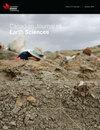A REASSESSMENT OF THE ERIE INTERSTADE FROM FIELD WORK IN THE CAYUGA BASIN, CENTRAL NEW YORK
IF 1.6
4区 地球科学
Q3 GEOSCIENCES, MULTIDISCIPLINARY
引用次数: 0
Abstract
The Erie Interstade is generally accepted to have been a relatively warm period associated with retreat of the Laurentian ice sheet (LIS) into the Ontario basin, followed by a readvance to the Valley Heads ice front in central New York. Recent investigations in the Cayuga basin indicate that this ice front retreated only to the Ithaca area during the Erie Interstade. In the Cayuga trough Erie lacustrine strata underlie Valley Heads deposits. Plant assemblages in these strata indicate a sub-arctic environment. Erie deposits also occur in the Fall Creek Valley, where a varved sequence below Valley Heads till and above Nissouri till indicate deposition close to a retreating ice front. Remanent magnetic declination in the varves, best correlated with lower Newport beds of the Middleville fm in the Mohawk Valley, suggest an age of 17.7±0.1 ka cal for the peak of the Erie retreat. Retreat only to the Ithaca area is based on lack of Erie deposits north of Ithaca, oscillation of the ice front around the south end of Cayuga Lake and the lack of a fluvial interval in the Cayuga trough that would have marked retreat into the Ontario basin. Ice core data from Greenland and sea level studies demonstrate that the Erie Interstade was neither a warm period nor a time of significant sea level rise. The Erie Interstade retreat/Valley Heads readvance appears instead to represent a minor reversal in the general, slow ice front retreat from the Last Glacial Maximum ( LGM).从纽约中部卡尤加盆地的实地工作中对伊利interstade的重新评估
伊利冰川期被普遍认为是一个相对温暖的时期,与劳伦斯冰盖(LIS)退缩到安大略盆地有关,随后进入纽约中部的谷头冰锋。最近对卡尤加盆地的调查表明,在伊利间期,这一冰锋只退到了伊萨卡地区。在卡尤加槽伊利湖地层下的谷头矿床。这些地层中的植物组合表明亚北极环境。伊利沉积物也出现在福尔克里克山谷,在那里,山谷头以下和密苏里州上方有一个弯曲的序列,表明沉积物靠近退缩的冰锋。与莫霍克山谷米德尔维尔地层下部纽波特层最相关的残余磁偏角表明,伊利撤退的峰值年龄为17.7±0.1 ka cal。只退到伊萨卡地区是基于伊萨卡北部缺乏伊利沉积物,卡尤加湖南端周围的冰阵振荡,以及卡尤加海槽中缺乏标志着退到安大略盆地的河流间隔。来自格陵兰岛的冰芯数据和海平面研究表明,Erie interstage既不是一个温暖期,也不是一个海平面显著上升的时期。Erie Interstade退缩/Valley Heads前进似乎代表了末次盛冰期(LGM)冰锋总体缓慢退缩的一个小逆转。
本文章由计算机程序翻译,如有差异,请以英文原文为准。
求助全文
约1分钟内获得全文
求助全文
来源期刊

Canadian Journal of Earth Sciences
地学-地球科学综合
CiteScore
2.80
自引率
7.10%
发文量
66
审稿时长
6-12 weeks
期刊介绍:
The Canadian Journal of Earth Sciences reports current research in climate and environmental geoscience; geoarchaeology and forensic geoscience; geochronology and geochemistry; geophysics; GIS and geomatics; hydrology; mineralogy and petrology; mining and engineering geology; ore deposits and economic geology; paleontology, petroleum geology and basin analysis; physical geography and Quaternary geoscience; planetary geoscience; sedimentology and stratigraphy; soil sciences; and structural geology and tectonics. It also publishes special issues that focus on information and studies about a particular segment of earth sciences.
 求助内容:
求助内容: 应助结果提醒方式:
应助结果提醒方式:


